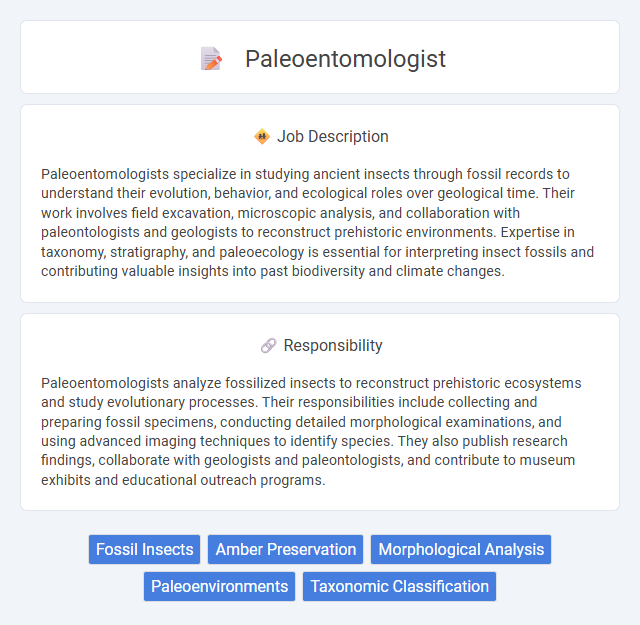
Paleoentomologists specialize in studying ancient insects through fossil records to understand their evolution, behavior, and ecological roles over geological time. Their work involves field excavation, microscopic analysis, and collaboration with paleontologists and geologists to reconstruct prehistoric environments. Expertise in taxonomy, stratigraphy, and paleoecology is essential for interpreting insect fossils and contributing valuable insights into past biodiversity and climate changes.
Paleoentomologists often work in challenging environments, such as field sites with variable weather and remote locations, which may not suit individuals who prefer stable office settings. Those with strong attention to detail, patience for meticulous fossil analysis, and a passion for ancient insects are more likely to thrive in this specialized career. Physical stamina and a genuine interest in both paleontology and entomology increase the probability of job satisfaction and success in this field.
Qualification
A paleoentomologist typically holds an advanced degree such as a Master's or Ph.D. in paleontology, entomology, or geology, with specialized coursework in fossil insects and stratigraphy. Proficiency in microscopy, fossil identification, and geochemical analysis is essential for analyzing insect specimens from ancient geological periods. Experience with fieldwork, laboratory techniques, and scientific research publications strengthens qualifications in this specialized branch of paleontology.
Responsibility
Paleoentomologists analyze fossilized insects to reconstruct prehistoric ecosystems and study evolutionary processes. Their responsibilities include collecting and preparing fossil specimens, conducting detailed morphological examinations, and using advanced imaging techniques to identify species. They also publish research findings, collaborate with geologists and paleontologists, and contribute to museum exhibits and educational outreach programs.
Benefit
Paleoentomologists likely experience significant benefits such as contributing to the understanding of ancient ecosystems and evolutionary biology, which may lead to advancements in scientific knowledge. They probably enjoy opportunities for fieldwork and fossil analysis that enhance their expertise and skill set. The job may offer a sense of fulfillment from uncovering mysteries of the past and collaborating with interdisciplinary teams in research institutions or universities.
Challenge
Paleoentomologists likely face the challenge of interpreting incomplete and fragmented fossil records, requiring advanced analytical skills and patience. The difficulty in accurately dating and identifying ancient insect species may demand extensive fieldwork and collaborative research efforts. Limited funding for specialized paleontological studies could also impact the scope and progress of their investigations.
Career Advancement
A career as a paleoentomologist offers opportunities to advance through research positions in universities, museums, and geological surveys, specializing in the study of ancient insects through fossil records. Expertise in paleobiology and advanced degrees such as a Ph.D. enable paleoentomologists to lead major fossil excavation projects and contribute to significant scientific publications. Professional growth often involves collaboration on interdisciplinary studies, securing research grants, and presenting findings at international conferences to establish authority in the field.
Key Terms
Fossil Insects
Paleoentomologists specialize in studying fossil insects to understand ancient ecosystems and evolutionary processes. They analyze insect fossils preserved in amber, shale, and sedimentary rock, employing microscopy and imaging techniques to identify species and their morphological traits. Their research provides crucial insights into climate change, biodiversity shifts, and the ecological roles of insects throughout geological history.
Amber Preservation
Paleoentomologists specialize in studying fossilized insects, with a strong emphasis on specimens preserved in amber due to its exceptional ability to maintain fine anatomical details. Amber preservation provides a unique window into prehistoric ecosystems, allowing researchers to analyze insect morphology, behavior, and evolutionary history with remarkable accuracy. These scientists use advanced imaging techniques to examine amber-encased insects, contributing to our understanding of ancient biodiversity and ecological interactions.
Morphological Analysis
Paleoentomologists specialize in the morphological analysis of fossilized insects, examining features such as wing venation, body segmentation, and mouthpart structures to reconstruct evolutionary histories. This detailed study helps identify species, interpret ecological roles, and understand insect diversification through geological periods. Expertise in microscopy and imaging technologies enhances the accuracy of morphological assessments critical for paleobiological research.
Paleoenvironments
Paleoentomologists analyze fossilized insects to reconstruct ancient ecosystems and understand paleoenvironmental conditions. Their research provides critical insights into climate change, vegetation, and habitat dynamics of prehistoric eras. This information aids in interpreting biodiversity patterns and evolutionary processes over geological time scales.
Taxonomic Classification
Paleoentomologists specialize in the taxonomic classification of fossilized insects, utilizing morphological characteristics and advanced imaging techniques to categorize ancient species. They analyze specimens from various geological periods to understand evolutionary relationships and biodiversity shifts over time. This classification aids in reconstructing past ecosystems and contributes to broader paleontological research.
 kuljobs.com
kuljobs.com